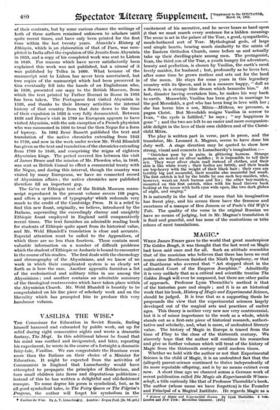THE ROYAL CHRONICLE OF ABYSSINIA.*
WHEN, at the end of 1771, James Bruce returned from his two years' sojourn in Abyssinia, that country was practically a terra incognita to European scholars ; it is true that Father Ludolf, at the end of the seventeenth century, had published his Historia Ethiopica, which was a mine of informations but Ludolf had never visited the country. Bruce, on the other hand, in his Voyage to Discover the Sources of the Nile, gave not only a most accurate first-hand description of the country, but also the results of his close study of the native Ethiopic chronicles, for the Abyssinians have from the earliest times shown, like the Chinese, a marked predilection for keeping State chronicles of their history. The Abyssinians were converted to Christianity in the middle of the fourth century, but their history goes-back to a far earlier period, and we have every reason to suppose that from the earliest days of the kingdom of Axum they were in the habit of recording their annals ; but various internal disturbances led to the destruc- tion of these records, and it is not until the re-establishment of the old dynasty in 1268 that we find the appointment of a Court Chronicler who was to draw up, year by year, the annals of the country under the title of Thi Chronicle of Axum. At the same time, the earlier history which had perished was rewritten, presumably from oral tradition, which had preserved the names of a long series of kings and such legends as those relating to the Queen of Sheba and King Solomon, and the manner in which Abyssinia was converted to Christianity. Bruce was not, however, the first to utilize these native chronicles, for several of the learned Jesuit missionaries who had resided in Abyssinia during the second half of the six. teenth and the beginning of theseventeenth centuries had made a very thorough study of them, notably Paez and Almeida, both of whom had written works containing a full account • Tha Royal Chronicle of Abyssinia, 1769-1840. With Translation and Not by H. Weld Blundell. Cambridie : At the University Press, [506.1
of their contents, but by some curious chance the writings of both of these authors remained unknown to scholars until quite recent times, and have only been printed for the first
time within the last twenty years. Almeida's History of Ethiopia, which is an elaboration of that of Paez, was com-
pleted in India after the expulsion of the Jesuits from Abyssinia in 1633, and a copy of his completed work was sent to Lisbon in 1640. For reasons which have never satisfactorily been
explained this work was not published, but a résumé of it was published by Tellez in 1660. What became of the manuscript sent to Lisbon. has never been ascertained, but two copies of the manuscript which had been preserved in Goa eventually fell into the hands of an Englishman who, in 1838, presented one copy to the British Museum, from which the text printed by Father Beceari in Rome in 1905 has been taken. The Portuguese first visited Abyssinia in 1520, and thanks to their literary activities the internal history of that country from that date down to the time of their expulsion in 1633 is very fully documented. Between 1638 and Bruce's visit in 1789 no European appears to have visited Abyssinia, with the sole exception of a French physician who was summoned in 1698 to treat the then Negus for a form of leprosy. In 1882 Rene Bassett published the text and translation of the native chronicles extending from 1842 to 1729, and now in the work under review Mr. Weld Blundell has given us the text and translation of the chronicles extending from 1769 to 1840, and comprising the reigns of eighteen Abyssinian kings. The period covered lies between the visit of James Bruce and the mission of Mr. Plowden who, in 1849, was sent as British Consul to effect a commercial treaty with the Negus, and during this interval, though the country was visited by many Europeans, we have no connected record of Abyssinian affairs ; the native chronicles now published therefore fill an important gap.
The Ge'ez or Ethiopic text of the British Museum manu- script reproduced in the present volume covers 198 pages, and offers a specimen of typography which redounds very much to the credit of the Cambridge Press. It is a relief to find this new fount, originally, we believe, introduced by the Italians, superseding the exceedingly clumsy and unsightly Ethiopic fount employed in England until comparatively recent times. The text furnishes an admirable reading book for students of Ethiopic quite apart from its historical value, and Mr. Weld Blundell's translation is close and accurate. Especial attention must be called to the Appendices, of which there are no less than fourteen. These contain most valuable information on a number of difficult problems which the student of Ethiopic or Amharic is bound to encounter in the course of his studies. The first deals with the chronology and chronography of the Abyssinians, and we know of no work in which their complicated system is so clearly set forth as is here the case. Another appendix furnishes a list of the ecclesiastical and military titles in use among the Abyssinians ; and another contains an admirable summary of the theological controversies which have taken place within the Abyssinian Church. Mr. Weld Blundell is heartily to be congratulated on his fine piece of scholarly work and on the liberality which has prompted him to produce this very handsome volwne.



































































 Previous page
Previous page